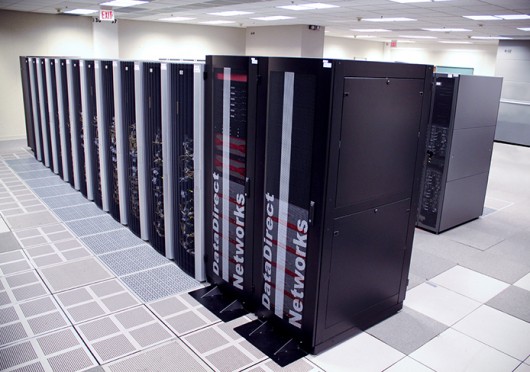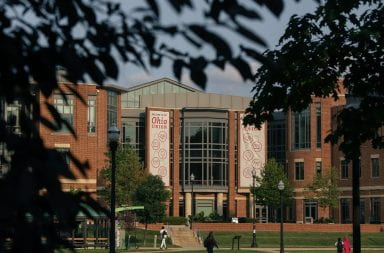Ohio State is known for the research it cultivates within multiple areas of study. But such large volumes of research require even larger tools.
OSU’s West Campus is home to Ohio’s statewide supercomputer, a resource that executive director of Ohio Supercomputer Center and Ohio Academic Resources Network Pankaj Shah said is 250,000 times faster than an iPhone 6.
“I look at the Supercomputer Center at OSU as being sort of the core of what we do in terms of the hands-on experience of data analytics. It is very central. In fact, probably the most critical resource that we have,” said Philip Payne, director of the Office of Academic Affairs Discovery Themes initiative and the Data Analytics Collaborative.
Data calculations that might have otherwise taken months or weeks to conduct can be done in a matter of minutes using the technology, Payne said.
“You have researchers that need to crunch thousands and thousands of numbers and data,” Mantey said. “It enables the research to be done faster and more appropriately.”
The Ohio Supercomputer Center is a statewide resource that provides “services and computational science expertise to Ohio university researchers as well as Ohio industries,” according to the OSC website.
When The National Science Foundation funded five campus computing centers around 1986, Ohio was not originally chosen as a location, but university faculty and legislators sought to bring a statewide supercomputer center to Ohio, which is now OSC, said Ohio Technology Consortium spokeswoman Susan Mantey.
“We are one of the few states in the nation that all of the universities in the state have access to such a powerful machine,” Shah said. “That’s what makes Ohio unique.”
And it is helps to make OSU distinct as well.
“One of the ways that we’re able to get the best and brightest from throughout the country to come to Ohio State and work in data analytics with us is because of this unparalleled resource we have with Ohio Supercomputer Center,” Payne said.
According to OSC’s 2013-14 annual report, OSU is responsible for 75 percent of the supercomputer center’s usage by an academic institution. As OSC is open to all Ohio universities, Ohio State’s system usage is indicative of the sheer strength and volume at which researchis being conducted at OSU, Shah said.
Payne said the supercomputer has become even more vital as a result of OSU’s Discovery Themes initiative. It’s a $400 million initiative, which began in October 2012, and is the university’s “natural evolution” of embracing its land-grant mandate to bring practical results of its research to the community, according to an OSU website.
“We’ve been talking about, for about two years how to use some of the new money that we’ve been able to bring in through creative financing like the commercialization of our parking resources. We’ve been looking at how we can use that to improve the overall academic environment at Ohio State. The Discovery Themes is really the first initiative to do that,” Payne said.
Two years ago, OSU leased its parking operations to Australian private investment firm QIC Global Infrastructure in a 50-year, $483 million deal.
Part of the initiative includes creating degree programs that are responsive to the needs of the community, Payne said.
“An example of that is actually the data analytics undergraduate major that we have, which was actually the first of its kind in the country. We built that because a number of employers in the Central Ohio area and really in the Midwest came to us and said we need more entry level employees to have skills in data analytics,” Payne said.
The data analytics undergraduate major was approved by the Council on Academic Affairs in February, according to an OSU website.
OSC will support all activities behind the scenes of the Discovery Themes initiative data analytics program, Shah said.
The emphasis of experiential training in the data analytics undergraduate degree means students are able to work with the supercomputer just as researchers would. This includes computations and experimental simulations, Payne said.
Third-year graduate student in computer scienceRoee Ebenstein said he used the OSC resources for research, work and class.
“I used it for one class I took,” Ebenstein said in an email. “We used the OSC resources for isolating our experiment’s performance measurement and for using special hardware that is not available on the departmental resources.”
Ebenstein said the OSC resource fast and reliable.
“For researches, it is usually important to know that the experiments being conducted are not being affected by external factors and have reliable results,” he said. “OSC environment is set up exactly for that.”
Although he wishes that he could make more visits to OSC, Ebenstein said having such a powerful tool on OSU’s campus is advantageous.
“Data analytics discovers relations that we could have not uncover without it. The supercomputer is just the glue that allows us to tunnel the data to discoveries and innovations faster,” he said.
It is the university’s responsibility to make optimal use of resources like the supercomputer to stay relevant to the community, Payne said.
“It’s not sufficient just to engage with scholarship. We need to engage in scholarship that both advances the state of knowledge and has a meaningful impact for the community around us,” he said. “I think that’s sort of our big opportunity at Ohio State.”
OSC is funded by the State of Ohio, through the Ohio Board of Regents, Shah said. Mantey was not able to provide an exact cost by Thursday evening.



